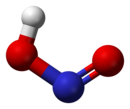This is an old revision of this page, as edited by CheMoBot (talk | contribs) at 02:30, 7 August 2011 (Updating {{chembox}} (changes to verified and watched fields - updated 'DrugBank_Ref', 'UNII_Ref', 'ChEBI_Ref') per Chem/Drugbox validation (report errors). The present address (URL) is a permanent link to this revision, which may differ significantly from the current revision.
Revision as of 02:30, 7 August 2011 by CheMoBot (talk | contribs) (Updating {{chembox}} (changes to verified and watched fields - updated 'DrugBank_Ref', 'UNII_Ref', 'ChEBI_Ref') per Chem/Drugbox validation (report errors)(diff) ← Previous revision | Latest revision (diff) | Newer revision → (diff) | |
| Names | |
|---|---|
| Preferred IUPAC name Nitrous acid | |
| Systematic IUPAC name Hydroxidooxidonitrogen | |
| Identifiers | |
| CAS Number | |
| 3D model (JSmol) | |
| ChEBI | |
| ChEMBL | |
| ChemSpider | |
| ECHA InfoCard | 100.029.057 |
| EC Number |
|
| Gmelin Reference | 983 |
| KEGG | |
| MeSH | Nitrous+acid |
| PubChem CID | |
| CompTox Dashboard (EPA) | |
InChI
| |
SMILES
| |
| Properties | |
| Chemical formula | HNO2 |
| Molar mass | 47.013 g/mol |
| Appearance | Pale blue solution |
| Density | Approx. 1 g/ml |
| Melting point | Only known in solution |
| Acidity (pKa) | 3.398 |
| Hazards | |
| Flash point | Non-flammable |
| Related compounds | |
| Other anions | Nitric acid |
| Other cations | Sodium nitrite Potassium nitrite Ammonium nitrite |
| Except where otherwise noted, data are given for materials in their standard state (at 25 °C , 100 kPa).
| |
Nitrous acid (molecular formula HNO2) is a weak and monobasic acid known only in solution and in the form of nitrite salts.
Nitrous acid is used to make diazides from amines; this occurs by nucleophilic attack of the amine onto the nitrite, reprotonation by the surrounding solvent, and double-elimination of water. The diazide can then be liberated to give a carbene or carbenoid.
Structure
In the gas phase, the planar nitrous acid molecule can adopt both a cis and a trans form. The trans form predominates at room temperature, and IR measurements indicate it is more stable by around 2.3 kJ mol.
 |
 |
 |
(from the microwave spectrum) |
Preparation
When cold, dilute solutions of nitrite ion, NO2 are carefully acidified, a light blue solution of nitrous acid is produced. Free nitrous acid is unstable and decomposes rapidly.
Decomposition
See also: Dinitrogen trioxideIn anything other than very dilute, cold solutions, nitrous acid rapidly decomposes into nitrogen dioxide, nitric oxide, and water:
- 2 HNO2 → NO2 + NO + H2O
Nitrogen dioxide disproportionates into nitric acid and nitrous acid in aqueous solution:
- 2 NO2 + H2O → HNO3 + HNO2
In warm or concentrated solutions, the overall reaction amounts to production of nitric acid, water, and nitric oxide:
- 3 HNO2 → HNO3 + 2 NO + H2O
Chemistry
Nitrous acid is used to prepare diazonium salts:
- HNO2 + ArNH2 + H → ArN2 + 2 H2O
where Ar is an aryl group.
Such salts are widely used in organic synthesis, e.g., for the Sandmeyer reaction and in the preparation azo dyes, brightly-colored compounds that are the basis of a qualitative test for anilines. Nitrous acid is used to destroy toxic and potentially-explosive sodium azide. For most purposes, nitrous acid is usually formed in situ by the action of mineral acid on sodium nitrite:
- NaNO2 + HCl → HNO2 + NaCl
- 2 NaN3 + 2 HNO2 → 3 N2 + 2 NO + 2 NaOH
Reaction with two α-hydrogen atoms in ketones creates oximes, which may be further oxidized to a carboxylic acid, or reduced to form amines. This process is used in the commercial production of adipic acid.
Nitrous acid reacts rapidly with aliphatic alcohols to produce alkyl nitrites, which are potent vasodilators:
- (CH3)2CH-CH2-CH2-OH + HNO2 → (CH3)2CH-CH2-CH2-ONO + H2O
Atmosphere of the earth
| This section does not cite any sources. Please help improve this section by adding citations to reliable sources. Unsourced material may be challenged and removed. (June 2010) (Learn how and when to remove this message) |
Nitrous acid is involved in the ozone budget of the lower atmosphere: the troposphere. The heterogeneous reaction of nitrogen monoxide (NO) and water produces nitrous acid. When this reaction takes place on the surface of atmospheric aerosols, product readily photolyses to hydroxyl radicals.
See also
References
- Greenwood, Norman N.; Earnshaw, Alan (1997). Chemistry of the Elements (2nd ed.). Butterworth-Heinemann. ISBN 978-0-08-037941-8. p. 462
-
Kameoka, Yohji; Pigford, Robert (1977). "Absorption of Nitrogen Dioxide into Water, Sulfuric Acid, Sodium Hydroxide, and Alkaline Sodium Sulfite Aqueous". Ind. Eng. Chem. Fundamen. 16 (1): 163–169. doi:10.1021/i160061a031.
{{cite journal}}: Unknown parameter|month=ignored (help) - Clarke, H. T.; Kirner, W. R. "Methyl Red" Organic Syntheses, Collected Volume 1, p.374 (1941). http://www.orgsyn.org/orgsyn/pdfs/CV1P0374.pdf
- Prudent practices in the laboratory: handling and disposal of chemicals. Washington, D.C.: National Academy Press. 1995. ISBN 0309052297.